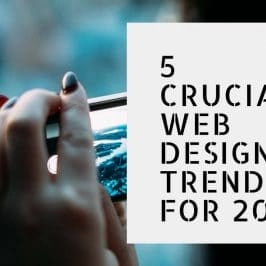5 Crucial Web Design Trends from 2017

Web Design Trends: Lessons from the Past for Today’s NZ Websites (Reflecting on 2017)
In any industry, change is constant, and the same holds true for web design. New trends are always a driving factor, pushing the industry forward. It’s interesting to look back at trends that emerged strongly in the past and see how they’ve evolved or remain crucial today.
Around 2017, several key web design trends gained prominence. Even if you’re focused on cost-effective website design today, understanding these foundational shifts is important. Let’s look back at what became standard practice around that time:
Key Trends from 2017 That Still Shape Web Design
The Enduring Importance of the Mobile-First Approach
The mobile-first design approach, which involves designing the mobile experience first before scaling up for larger screens, was gaining significant traction from around 2015. By 2017, with mobile phones recognised as the primary Browse device for many users, it became impossible to ignore. Designing content to fit and function beautifully on mobile devices first, then adapting for tablets and desktops, became a core principle, especially with Google’s move towards mobile-first indexing.
Responsive Design: A Non-Negotiable Standard
The idea of responsive design wasn’t new even back in 2017, but around that time, even large brands fully embraced it. The bonus of this approach remains clear: you generally pay for developing a single site that delivers content effectively on both small and large screens. Furthermore, mobile-friendliness officially became a significant Google ranking factor around April 2015, solidifying responsive design’s importance. With a responsive design, your website’s content automatically adjusts its layout for different devices.
Conversational UI: Evolution into AI and Chatbots
Around 2017, there was significant buzz about interacting with websites and companies through chat, messaging, and other language interfaces. Messaging platforms like Slack, WeChat, and Facebook Messenger were prevalent, and it was seen as the time for companies to consider utilising them more directly for customer interaction. While direct integration with social messengers continues, this trend has largely evolved into the sophisticated chatbots and AI-driven customer service interfaces common today.
Motion Design: Beyond GIFs (Animations & Performance)
Many websites were already using animations back then, but a trend observed around 2017 was the increasing use of animated GIFs for more than just decoration. Given their use on social platforms, their application in web design grew too. The key then, as now, is strategic use – not overusing them but employing motion effectively to draw attention, explain workflows, enrich product experiences, or guide users. Today, the focus has also shifted towards performance-friendly animation techniques like Lottie files and CSS animations.
Authenticity Over Stock: The Power of Real Images
While creating a cost-effective web design is often a goal, the idea that you shouldn’t cut corners with generic stock images really took hold around 2017. Users increasingly preferred seeing authentic images relating specifically to the company. The era of relying solely on generic visuals was fading. To add authentic visuals, custom photography became key. The principle remains vital: everything on your site, including images, should serve a purpose and feel genuine. A popular approach that emerged was putting a face to the brand by sharing authentic team photos, which builds trust and connection – a core tenet of good web design best practices.
Staying Current: Applying Design Principles Today
Many other trends emerged around that time, and the web design landscape continues to evolve rapidly. Staying current with best practices and understanding how users interact with websites across all devices remains essential for success online in 2025 and beyond.